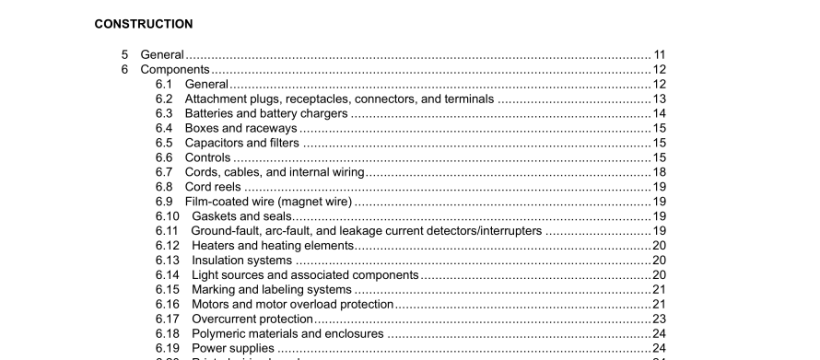UL 73-2020 pdf download.Motor-Operated Appliances.
2.6 AUTOMATICALLY CONTROLLED APPLIANCE – An appliance is considered to be automatically controlled if: a) The repeated starting of the appliance, beyond one complete predetermined cycle of operation to the point where some form of limit switch opens the circuit, is independent of any manual control; b) During any single predetermined cycle of operation, the motor is caused to stop and restart one or more times; c) Upon energizing the appliance, the initial starting of the motor may be intentionally delayed beyond normal, conventional starting; or d) During any single predetermined cycle of operation, automatic changing of the mechanical load may reduce the motor speed sufficiently to reestablish starting-winding connections to the supply circuit. 2.7 COMPONENT – A device or fabricated part of the appliance covered by the scope of a safety standard dedicated to the purpose. When incorporated in an appliance, equipment otherwise typically field installed (e. g. luminaire) is considered to be a component. Unless otherwise specified, materials that compose a device or fabricated part, such as thermoplastic or copper, are not considered components. 2.8 COUNTER-SUPPORTED APPLIANCE – An appliance that is physically supported by a counter, table or bench during the performance of its intended function. 2.9 CORD CONNECTOR – A female contact device wired on flexible cord for use as an extension from an outlet to make a detachable electrical connection to an attachment plug or, as an appliance coupler, to an equipment inlet. 2.10 CONTROL, AUTOMATIC ACTION – A control in which at least one aspect is non-manual. 2.11 CONTROL, AUXILIARY – A device or assembly of devices that provides a functional utility, is not relied upon as an operational or protective control, and therefore is not relied upon for safety. For example, an efficiency control not relied upon to reduce the risk of electric shock, fire, or injury to persons during normal or abnormal operation of the end product is considered an auxiliary control.
2.15 CONTROL, TYPE 1 ACTION – The actuation of an automatic control for which the manufacturing deviation and the drift (tolerance before and after certain conditions) of its operating value, operating time, or operating sequence has not been declared and tested under this standard. 2.16 CONTROL, TYPE 2 ACTION – The actuation of an automatic control for which the manufacturing deviation and the drift (tolerance before and after certain conditions) of its operating value, operating time, or operating sequence have been declared and tested under this standard. 2.17 FIXED APPLIANCE – Any equipment or appliance that is provided with a facitily to be fastened or otherwise secured in a specific location. 2.18 LINE-VOLTAGE CIRCUIT – A circuit involving a potential of not more than 600 V and having circuit characteristics in excess of those of a low-voltage circuit. 2.19 LOW-VOLTAGE CIRCUIT – A circuit involving a peak open-circuit potential of not more than 42.4 V supplied by a primary battery, by a Class 2 transformer, or by a combination of a transformer and a fixed impedance that as a unit, complies with all performance requirements for a Class 2 transformer. A circuit derived from a line-voltage circuit by connecting a resistance in series with the supply circuit as a means of limiting the voltage and current, is not considered to be a low voltage circuit. 2.20 PORTABLE APPLIANCE – An appliance that is easily carried or moved from one place to another in normal use. 2.21 RECESSED ULTRASONIC CLEANER– An ultrasonic cleaner that is intended to be installed with the top portion of the appliance above a countertop, and with the bottom and all sides of the enclosure located beneath the countertop. The appliance controls (such as on/off switches) and top cover (safety door) are located above the countertop. 2.22 REMOTELY CONTROLLED APPLIANCE – An appliance that is out of sight of the operator who is at the starting device.UL 73-2020 pdf download.
UL 73-2020 pdf download
